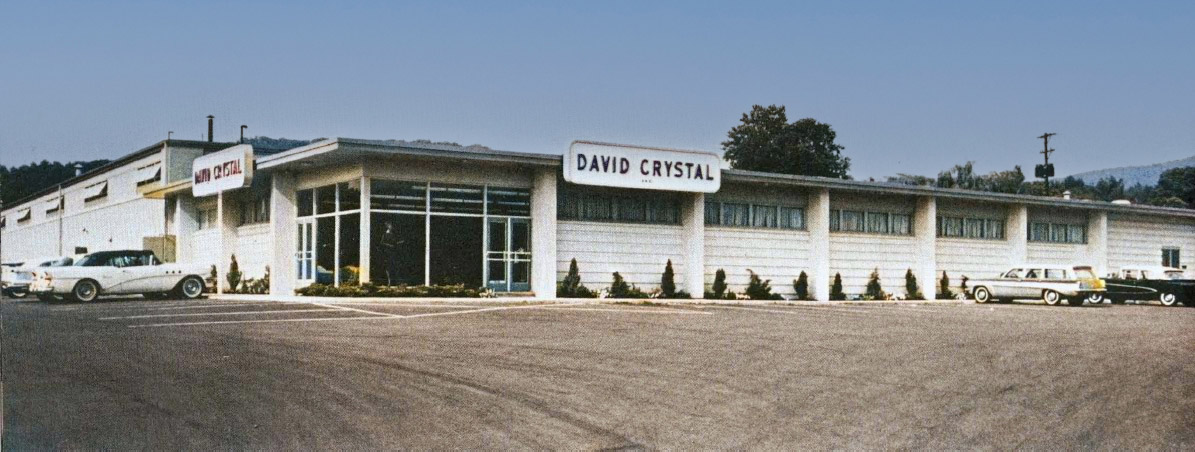For most of the 20th century, the corner of North 13th and Rosemont Streets marked one of Reading’s busiest pieces of the apparel trade. David Crystal’s Reading operations stitched New York–designed dresses, finished precut garments, and—by the Izod/Lacoste era—handled everything from corporate offices and warehousing to the famous crocodile logo work on-site. The company’s local footprint helped power the factory-to-outlet evolution that put Reading on bus tour itineraries nationwide.
David Crystal activity in Reading reaches back to the 1920s, when the firm was an early adopter of factory “outlet” selling on Moss Street (listed at 1141 Moss Street)—one reason Reading is often credited as a forerunner of the outlet idea. By mid-century, stitching and finishing work tied to New York cutting rooms was routine at Reading plants like Dorsyl Dress (7th & Washington). A new plant complex at 13th & Rosemont was built in 1960, anchoring the company’s northeast-side presence (the complex is often referenced as 13th & Rockland and listed at 2101 N. 13th St.). In 1969, the company was acquired by General Mills; later, General Mills’ apparel assets were spun out as Crystal Brands in 1985. Locally, the Izod/Lacoste Golf & Tennis division operated “entirely in Reading,” with corporate offices, warehousing, and logo stitching done in town—functions tied to the 13th Street complex.
Work at the Reading dress plants was unionized early. In 1933, amid a wave of needle-trades strikes across eastern Pennsylvania, an estimated 300 David Crystal workers from Reading joined actions that pushed the company to sign a contract with the International Ladies’ Garment Workers’ Union (ILGWU) that September. That figure gives a conservative sense of the plant’s scale during the New Deal upturn in garment organizing; later decades saw continued representation as the industry consolidated into larger brands. (Nationally, ILGWU later merged into UNITE in 1995.)
Reading stitched and finished David Crystal’s New York–designed dresses—everything from washable house dresses to silk frocks for higher-end boutiques—in the classic mid-century split between design centers and regional sewing floors. Decades later, when the crocodile came to dominate American casualwear, Reading’s Izod/Lacoste Golf & Tennis division based itself here, keeping corporate, warehouse, and on-garment logo operations local. The address 2101 N. 13th St. appears in state records tied to Crystal/Izod retail and distribution listings, reinforcing the site’s role as a hub rather than just a storefront.
David Crystal is one of the names that made Reading synonymous with outlet shopping. By the 1970s, tour buses were pouring into the city; national coverage at the time routinely paired “Talbott and David Crystal” as the legacy anchors, while local guides sent shoppers to the David Crystal outlet on the city’s northeast side. The Moss Street cluster and 13th-Street site sat alongside Vanity Fair and the Great Factory Store, forming the core itinerary that earned Reading its “Outlet Capital” reputation.
Corporate ownership in the apparel industry shifted steadily as consolidation reshaped the business. After the General Mills years, Crystal Brands carried well-known labels such as Izod and Lacoste through the 1980s. By 1995, the company’s apparel group—including Izod and Gant—was purchased by Phillips-Van Heusen (PVH), a clear sign that design and licensing were moving farther away from the old regional sewing base.
In Reading, the 13th & Rosemont complex followed a similar trajectory of change. Retail and plant operations there ceased by early 1995, during Crystal Brands’ Chapter 11 bankruptcy filing (January 21, 1994) and just before PVH finalized its acquisition on February 17, 1995. With that transition, David Crystal/Crystal Brands no longer operated the site, leaving the property largely inactive for more than two decades. Eventually, Albright College acquired the complex in July 2017 and cleared it around 2019.
Below: Demolition of David Crystal’s at 2101 N. 13th St.




Leave A Comment